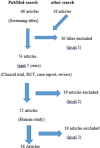Systematic analysis of factors that cause loss of preload in dental implants
- PMID: 30111906
- PMCID: PMC6070846
- DOI: 10.4103/jips.jips_294_17
Systematic analysis of factors that cause loss of preload in dental implants
Abstract
Screw loosening is the most common factor associated with dental implant failure. One of the major cause for screw loosening is the "loss of preload". Several factors including screw geometry, material properties particularly stiffness, surface texture and condition of mating surfaces, degree of lubrication, rate of tightening, integrity of joint etc.
Objective: This review analyses the factors that are responsible for the loss of preload.
Material and methods: Screw geometry, Implant- Abutment Connection type (external hexagon platform, morse taper), Material properties viz Stiffness, Resilience, Materials viz gold, titanium, titanium alloy, Surface texture of the abutment screw, Condition of mating surfaces, Lubrication, Torque value, Rate of tightening (10, 20, 35N and retorque after 10mins) are taken into consideration in this study. The MEDLINE-PubMed database was searched from September 2016 to 10 years previously. Several journals were hand searched and from cross references. The outcome analysed are the factors that are responsible for loss of preload.
Results: The search yielded 84 articles. After excluding duplicated abstracts and applying the inclusion and exclusion criteria, 36 studies were eligible for analysis. The result shows that loss of preload can occurs depending upon the type of material used, torque method, torque sequences, abutment connection type, influence of lubrication, abutment collar length. However we detected some potential limitations in the studies selected, mainly a minimum number of samples used for the study. Hence we suggest further studies to guarantee an excellence in methodological quality.
Conclusion: Based on the available data it can be summarized that the knowledge of preload loss must be known for the clinicians to avoid such screw loosening and subsequent implant failure.
Keywords: Abutment screw; dental implant; preload.
Conflict of interest statement
There are no conflicts of interest.
Figures
Similar articles
-
Implant Bio-mechanics for Successful Implant Therapy: A Systematic Review.J Int Soc Prev Community Dent. 2020 Nov 24;10(6):700-714. doi: 10.4103/jispcd.JISPCD_138_20. eCollection 2020 Nov-Dec. J Int Soc Prev Community Dent. 2020. PMID: 33437702 Free PMC article. Review.
-
Review of the Mechanical Behavior of Different Implant-Abutment Connections.Int J Environ Res Public Health. 2020 Nov 23;17(22):8685. doi: 10.3390/ijerph17228685. Int J Environ Res Public Health. 2020. PMID: 33238476 Free PMC article. Review.
-
Clinical Assessment of Preload Maintenance in the Abutment Screws of Single Posterior Implants After 1 Month of Use.Int J Oral Maxillofac Implants. 2021 Jan-Feb;36(1):177-181. doi: 10.11607/jomi.8316. Int J Oral Maxillofac Implants. 2021. PMID: 33600539 Clinical Trial.
-
Probabilistic analysis of preload in the abutment screw of a dental implant complex.J Prosthet Dent. 2008 Sep;100(3):183-93. doi: 10.1016/S0022-3913(08)60177-8. J Prosthet Dent. 2008. PMID: 18762030
-
Finite element analysis to determine implant preload.J Prosthet Dent. 2003 Dec;90(6):539-46. doi: 10.1016/j.prosdent.2003.09.012. J Prosthet Dent. 2003. PMID: 14668754
Cited by
-
Implant Mechanics, Biological Milieu, and Peri-Implantitis: A Narrative Review.Cureus. 2024 Aug 19;16(8):e67173. doi: 10.7759/cureus.67173. eCollection 2024 Aug. Cureus. 2024. PMID: 39295709 Free PMC article. Review.
-
Assessment of Preload Loss after Cyclic Loading in the OT Bridge System in an "All-on-Four" Rehabilitation Model in the Absence of One and Two Prosthesis Screws.Materials (Basel). 2022 Feb 20;15(4):1582. doi: 10.3390/ma15041582. Materials (Basel). 2022. PMID: 35208121 Free PMC article.
-
Assessment of the Survival of a Single Implant-Supported Cantilever Prosthesis in the Anterior Mandible.J Pharm Bioallied Sci. 2021 Nov;13(Suppl 2):S1668-S1671. doi: 10.4103/jpbs.jpbs_403_21. Epub 2021 Nov 10. J Pharm Bioallied Sci. 2021. PMID: 35018052 Free PMC article.
-
Effect of Application of a Bio-Adhesive on the Removal Torque Value and Rotational Misfit at the Implant-Abutment Junction: An In Vitro Study.Materials (Basel). 2021 Nov 12;14(22):6832. doi: 10.3390/ma14226832. Materials (Basel). 2021. PMID: 34832236 Free PMC article.
-
Implant Bio-mechanics for Successful Implant Therapy: A Systematic Review.J Int Soc Prev Community Dent. 2020 Nov 24;10(6):700-714. doi: 10.4103/jispcd.JISPCD_138_20. eCollection 2020 Nov-Dec. J Int Soc Prev Community Dent. 2020. PMID: 33437702 Free PMC article. Review.
References
-
- Breeding LC, Dixon DL, Nelson EW, Tietge JD. Torque required to loosen single-tooth implant abutment screws before and after simulated function. Int J Prosthodont. 1993;6:435–9. - PubMed
-
- Goheen KL, Vermilyea SG, Vossoughi J, Agar JR. Torque generated by handheld screwdrivers and mechanical torquing devices for osseointegrated implants. Int J Oral Maxillofac Implants. 1994;9:149–55. - PubMed
-
- Burguete RL, Johns RB, King T, Patterson EA. Tightening characteristics for screwed joints in osseointegrated dental implants. J Prosthet Dent. 1994;71:592–9. - PubMed
-
- Sakaguchi RL, Borgersen SE. Nonlinear contact analysis of preload in dental implant screws. Int J Oral Maxillofac Implants. 1995;10:295–302. - PubMed
-
- Weiss EI, Kozak D, Gross MD. Effect of repeated closures on opening torque values in seven abutment-implant systems. J Prosthet Dent. 2000;84:194–9. - PubMed
Publication types
LinkOut - more resources
Full Text Sources
Other Literature Sources


